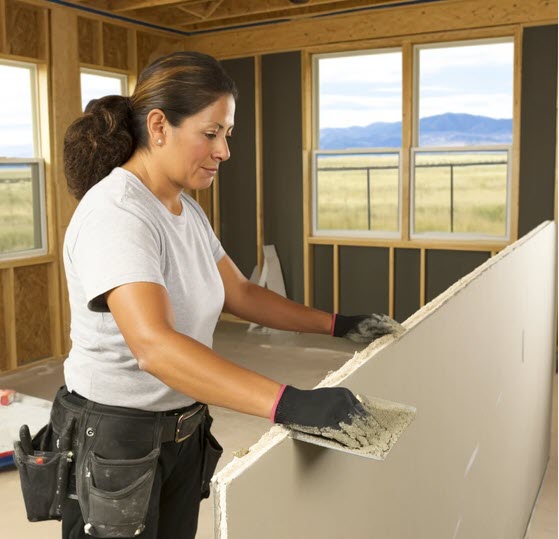Drywall Setup Made Easy: Tips for Perfect Results
Drywall setup is frequently regarded as a difficult task, yet with the ideal approach and understanding, it can become a workable undertaking. Grasping strategies for cutting, hanging, and ending up drywall can considerably influence the outcome.
Selecting the Right Materials
Choosing the ideal materials for drywall setup is crucial to accomplishing a sturdy and visually pleasing coating. drywall repair. The primary component, drywall sheets, normally come in different thicknesses, with 1/2-inch sheets being common for interior walls. For areas needing added dampness resistance, such as restrooms or cooking areas, think about utilizing environment-friendly board or concrete board, which are particularly made to endure moisture

Furthermore, choosing the ideal bolts-- either screws or nails-- is crucial for securing the drywall to the framework. Drywall screws are normally preferred for their holding power and lowered danger of popping. Finally, take into consideration the finishing touches such as primer and paint, which not only boost the look however likewise safeguard the drywall from dampness and wear.
Preparing the Setup Location
Before beginning the drywall installment process, it is crucial to prepare the setup location thoroughly. A clean work space decreases the threat of damage to existing things and allows for effective activity during installment.
Next, check the wall surfaces and ceiling for any flaws, such as splits, openings, or mold and mildew. Address these issues in advance; patch any damages and permit enough time for repair work to completely dry. In addition, guarantee that electric outlets, buttons, and plumbing are appropriately placed and accounted for, as this will affect drywall positioning.
Consider the environmental conditions. A secure temperature level and moisture degree are essential for optimum attachment and efficiency of the drywall products. Make use of a dehumidifier or heating system to produce appropriate conditions. if needed.
Trimming and Hanging Drywall
The secret to effective drywall installation lies in the precise cutting and dangling of the panels. Begin by gauging the room properly, taking right into account any type of obstructions such as electric outlets or home windows. Utilize a straight edge and an energy blade to rack up the drywall along your measurements, after that break it along the scored line for a clean break. For even more complex cuts, such as around outlets, a drywall saw can be used for precision.

Constantly work from the top down and entrusted to right, ensuring that you keep a staggered pattern to enhance security. Correctly hanging the drywall establishes the foundation for a smooth surface, eventually leading to premium results in your drywall job.
Insulation and Mudding Techniques
While appropriate cutting and dangling of drywall sets the stage, the following vital action includes mastering taping and mudding strategies to guarantee a seamless surface. Taping is crucial for reinforcing joints and stopping cracks; it entails embedding tape into the applied joint compound (mud) Beginning with a quality more information fiberglass or paper tape, applying the tape over the joint and pressing it right into the damp mud using a taping knife, guaranteeing no air bubbles stay.
As soon as the tape remains in location, use a slim layer of joint substance over the tape, feathering the sides to develop a smooth change to the drywall surface. Allow this layer to dry totally prior to sanding it gently to eliminate blemishes. Repeat this procedure, using added layers of mud as essential-- typically a couple of coats-- while gradually widening the application area with each layer to achieve a smooth appearance.
After the last layer dries out, sand the surface area with a fine-grit sandpaper up until smooth. sheetrock repair fort worth. Remember to put on a mask throughout fining sand to prevent inhaling dust fragments. useful link Grasping these taping and mudding methods is important for attaining a professional-quality coating in your drywall setup
Completing Touches for Perfection
Achieving a perfect drywall installation exceeds mudding and taping; it finishes in the completing touches that raise the overall look. These last actions are vital in ensuring a professional-grade coating that improves the appearances of your room.
Begin by fining sand the dried joint substance to create a smooth surface area. drywall repair. After sanding, wipe down the wall surfaces with a moist towel to remove any kind of dirt bits, ensuring a clean surface area for painting.
Following, use a primer particularly designed for drywall. This step is crucial, as it assists secure the joint compound and offers a consistent base for the topcoat. When the guide dries, examine for any kind of imperfections, and retouch as required.
Conclusion
Finally, effective drywall installation hinges on the cautious option of products, detailed prep work of the installation area, my response and accurate execution of cutting and hanging methods. Proficiency of taping and mudding procedures is vital for attaining a smooth coating. Additionally, interest to completing touches, consisting of priming and touch-ups, ensures a professional-grade result. By adhering to these standards, the top quality of handiwork can be significantly improved, adding to the general visual and performance of the area.
Drywall installment is often regarded as a challenging task, yet with the appropriate approach and knowledge, it can come to be a convenient undertaking.Picking the proper materials for drywall setup is important to accomplishing a long lasting and visually pleasing surface.Before starting the drywall installment process, it is vital to prepare the installation location completely. Mastering these taping and mudding techniques is vital for achieving a professional-quality finish in your drywall installment.
In final thought, successful drywall installment hinges on the mindful choice of materials, thorough prep work of the setup area, and specific implementation of cutting and hanging strategies.